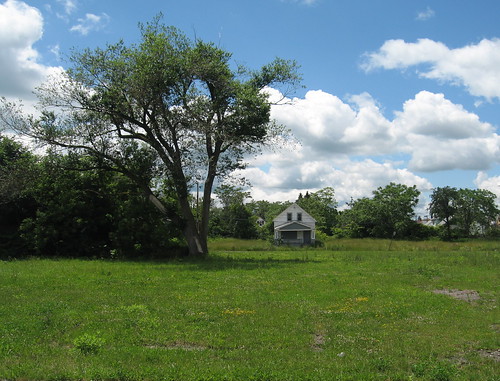Meet the forgotten housing crisis. While most attention has focused on the wave of foreclosures sweeping mostly middle-class, suburban Sunbelt neighborhoods from California to Florida, the nation's emptiest neighborhoods have remained concentrated in the same place for nearly a generation: the mostly minority, poor, urban neighborhoods of the American Rust Belt.
"I'd move in a heartbeat if I had somewhere to go right now," said Cindy Olejniczak of Buffalo, raking trash from the lawn of a boarded-up house to keep it from blowing in her yard. Roughly every third home in her neighborhood is vacant. Not even pizzerias will deliver to the area now.
"It's almost like you wish they would just level the whole neighborhood," she said, "and start rebuilding again from scratch."
more Buffalo 'urban prairie' pics
The AP analysis relies on US Postal Service and HUD data about emerging vacancy patterns. In Buffalo, LISC-Buffalo has been at the vanguard of analyis and public policy development around vacancy issues and urban land use development. Last year I posted this - Undeliverable & Unbelievable - Unstoppable? - that borrows heavily on LISC's distillation of this mountain of data in the US Postal Service/HUD mash-up.
Today's short AP video - Empty Neighborhoods - shouldn't be missed.Anthony (Armstrong LISC-Buffalo Program Officer) advises that the AP only counted "vacant" not the "no stat" category, which means they vastly under-report the problem in chronically stressed tracts. Tract 27.02 reported at 30% vacant, but with no stats it would have been 37.6%, the worst of them, tract 28 has a combined "vacant" and "no stat" of 39.1%, but this only showed up as 27.6% in the AP tables.
Creative Class • Shrinking Cities • Saturdays in the Neighborhood


4 comments:
I am from the City of Buffalo. I will not read this or any article like it because then I will have to think about ways to improve the situation in a rational and substantive way. No not for me. Please stop writing about these issues it is too negative.
Oh and stop contributing to publicity about it either. The NY Times and other national press is wrong about this just like the other articles.
So you think if you ignore whats going on it will go away? Not enough people care or speak up. That is why we still have a "mayor" with no vision running the city further into decline.You seem to be in denial about your surroundings or you need an eye exam.There are other cities in similar problems that are creative and turning it all around. Remove the "mayor" and many of his do nothing sidekicks and get someone with a vision in the mayors office and you will begin to see positive changes. If everyone is writing about it and talking about Buffalo problems than they need to be addressed. Your denial is a good part of the problem you see around you.
There is a debate going on Buffalo Rising about this same topic but after twenty-three responses it all becomes rather tiresome with the same old rhetoric.
Allow me to present this question: is there really any one solution for Buffalo’s current housing blight?
No – I believe the solutions will occur in pockets of remediation and perhaps one house at a time in either renovation or demolition. The latter should be carried-out by Buffalo ReUse (Michael Gainer).
I am, however, continually perplexed as to why new housing stock is being built within the city limits. I believe some form of guidelines for removal should continue with no new residential housing. It is almost like filling a bucket with a hole in the bottom.
Yes, new housing should be implemented but only after the current glut of housing stock is reduced especially when you see newer homes in the same dilapidated state as the older ones.
Where or when did the common sense of urban planning disappear too?
Maybe I missed it. What and where are the other four?
Post a Comment